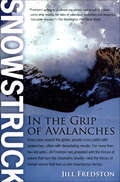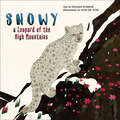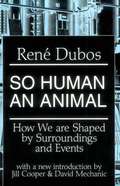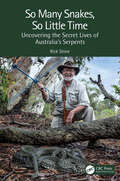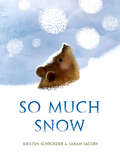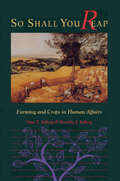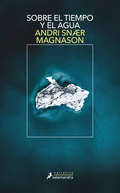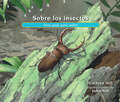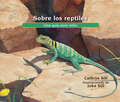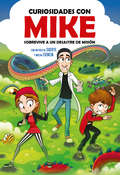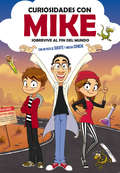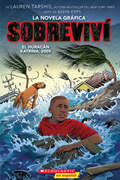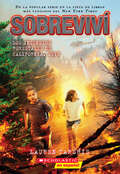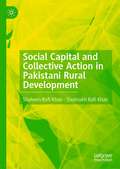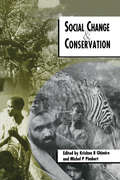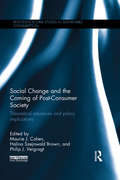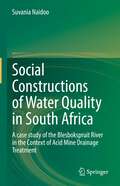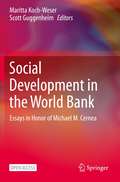- Table View
- List View
Snowmen at Night
by Caralyn Buehner Mark BuehnerHave you ever built a snowman and discovered the next day that his grin has gotten a little crooked, or his tree-branch arms have moved? And you've wondered . . . what do snowmen do at night? This delightful wintertime tale reveals all! Caralyn Buehner's witty, imaginative verse offers many amusing details about the secret life of snowmen and where they go at night, while Mark Buehner's roly-poly snowmen are bursting with personality and charm. From the highly successful team that created such winning titles as Fanny's Dream, Snowmen at Night is fabulous, frosty, and fun!
Snowshoe Trek to Otter River
by David BudbillThree short stories relate the adventures of twelve-year-old Daniel and his friend Seth while camping in the woods alone and together.
Snowstruck: In the Grip of Avalanches
by Jill FredstonEvery year around the globe, people cross paths with avalanches-some massive, some no deeper than a pizza box-often with deadly results. Avalanche expert Jill Fredston stalks these so-called freaks of nature, forecasting where and when they will strike, deliberately triggering them with explosives, teaching potential victims how to stay alive, and leading rescue efforts when tragedy strikes. Having spent decades trying to keep avalanches and people apart, Fredston brings them together unforgettably in Snowstruck. From a rare store of personal experience, she conveys a panorama of perspectives: a skier making what may prove his final decision, a victim buried so tightly that he can't move a finger, rescuers racing both time and weather, forecasters treading the line between reasonable risk and danger. Seamlessly interweaving these accounts, Fredston brings to life the awesome forces of nature that can turn the mountains deadly-and the equally inexorable forces of human nature that lure us time and again into treacherous terrain.
Snowy Owl Scientist (Scientists in the Field)
by Mark WilsonAre the snowy owls in trouble? Venture into the Alaskan arctic and the summer realm of these predator birds to find out. Discover the diverse species necessary to owl survival, how climate change is affecting the landscape of their nesting site of past millennia, and what it takes to do field research in this action-packed addition to the award-winning Scientists in the Field series.It's July on Alaska's North Slope, and scientist Denver Holt is in Utqiagvik surveying nests. Denver has been coming here since 1992, and the snowy owls he studies have been coming here much longer: thousands of years.With its mix of coastal, low-elevation tundra and a rich presence of lemmings, the North Slope is the only area in Alaska where snowy owls regularly nest. How do snowy owls decide where they will nest? How do they manage to arrive at locations where food will be abundant? What drives the success of these delicate tundra ecosystems? These are the mysteries Denver is trying to solve to help ensure a bright future for these elegant hunters.
Snowy, Blowy Winter
by Bob Raczka Judy SteadHow would you describe winter?Is it "freezy, stuffy, and sneezy?" Or do you think it's "glowy, rosy, and cozy?"No matter how you feel about winter, you are sure to enjoy Bob Raczka's tribute to the season's activities, tastes, and sounds. The simple rhymes using "y" words will encourage children to come up with their own words to describe the season.Judy Stead's exuberant art shows the fun of all things winter. Bob Raczka and Judy Stead previously teamed up to create Spring Things and Who Loves the Fall? With minimal text and cheerful art, these books work perfectly as an introduction to the seasons for the very young. The author lives in Illinois. The illustrator lives in North Carolina.
Snowy: A Leopard of the High Mountains
by Milisava PetkovicA heartwarming children&’s tale about a snow leopard who discovers the power of friendship in a time of great need.This heartwarming children&’s picture book tells the story of a little snow leopard cub who overcomes danger through friendship, patience, and courage.Snowy becomes separated from her mother as they run away from scary fur hunters. Lost and lonely, she makes new forest friends who teach her all she needs to find her way back home . . . Snowy: A Leopard of the High Mountains is a story that teaches children about respect for animals as it helps them get in touch with nature. It&’s a book they&’ll love to read again and again.&“This beautiful book teaches respect for animals and nature and the illustrations from Xuna Loc Xuan brings a whole spectrum of emotions to the table.&” —Jump Into a Book&“It's impossible not to fall in love with the work of Xuan Loc Xuan. . . . Illustrating strength and poignancy in measured, careful strokes, Xuan brings a whole spectrum of emotions to the table.&” —Kala Barba-Court, Plain Magazine&“Xuan Loc Xuan dresses up melancholy in vibrant colors . . . and the results are breathtaking.&” —Payal Khandelwal, The Floating MagazineThis is a fixed-format ebook, which preserves the design and layout of the original print book
Snuggle Time Love
by Glenys NellistA sweet collection of snuggle-time rhymes that leads children through 1 Corinthians 13 and shows them that love is patient, kind, and never, ever fails. Featuring cute, cuddly animal illustrations and read-aloud rhymes, this padded cover board book will delight children with its heartfelt poems all about LOVE based on the Scripture found in 1 Corinthians 13. A perfect baby gift or birthday present, this charming, lovable collection is sure to encourage any little one that they are loved unconditionally.
So Human an Animal: How We Are Shaped by Surroundings and Events
by René DubosIn this collection of stories, the bizarre is rendered normal, the absurd hilarious and the incredible comprehensible. The re-imaginations of reality feature evocations of historical figures, over-televised game show hosts and late-night comedians.<P><P> Pulitzer Prize Winner
So Many Snakes, So Little Time: Uncovering the Secret Lives of Australia’s Serpents
by Rick ShineSnakes are creatures of mystery, arousing fear in many people but fascination in a few. Recent research has transformed our understanding of the behaviour and ecology of these animals, revealed their important roles in diverse ecosystems, and discovered new and effective ways to conserve their populations and to promote coexistence between snakes and people. One of the leading contributors to that scientific revolution has been Prof Rick Shine. Based in Australia, whose snake fauna is diverse and often dangerous, his experiences and anecdotes will inspire a new generation of serpent scientists. Spellbinding stories highlight the challenges, frustrations, and joys of discovery, and give the reader a greater appreciation of these often-slandered slithering reptiles.Key Features Documents the important role played by a preeminent herpetologist. Focuses on research conducted in Australia, especially on snakes. Summarizes highly influential conservation studies. Explores the ways in which research has deepened our understanding of snakes.
So Much Snow
by Kristen SchroederA beautifully illustrated, rollicking read-aloud about forest animals who are caught—literally up to their ears and antlers—in a snowstorm.On Monday, it starts to snow.Silent swirling.How high will it go? Follow seven forest creatures, from a tiny mouse to a giant moose, as they hunker down in a snowstorm. As the week progresses, the snow piles up and up--even past Moose's antlers! On Sunday, the sun starts to melt the snow, and it seems that, as the next week passes and it grows sunnier, spring has finally sprung. But wait...is that more snow?! This cumulative picture book is at once beautiful and lyrical and playful and joyful, with charming illustrations by a highly acclaimed illustrator.
So Shall You Reap: Farming And Crops In Human Affairs
by Otto Solbrig Dorothy J. SolbrigSo Shall You Reap is a broad-gauged exploration of the intersections of farming and history. Beginning with the prehistorical era, Otto and Dorothy Solbrig describe the evolution of farming. When and how did people learn to irrigate, to fertilize, to rotate their crops -- and why? Along with its fundamental importance to history, farming has radically altered the physical world. Natural landscapes have been completely transformed to provide room for growth on a large scale of a few species of plants and even fewer species of domesticated animals. Agriculture has altered the earth's biosphere and changed its geosphere: The soil has been modified, forests have been felled, swamps have been drained, rivers have been dammed and diverted. So Shall You Reap presents a fresh and informed perspective on how farming and the crops we grow have changed us and our environment. By understanding the nature of the origins and evolution of agriculture, we will be better prepared to anticipate what the future may hold in store, and what must be done to increase food production while minimizing environmental problems.
Sobre el tiempo y el agua
by Andri Snaer MagnasonUn libro para comprender el futuro del planeta si no actuamos de inmediato. Sobre el tiempo y el agua es un ensayo narrativo profundo y convincente sobre la crisis medioambiental global y, a la vez, una íntima y desesperada súplica al mundo. Nació de una conversación con un científico puntero convencido de que son los escritores, y no los científicos, los más capacitados para hablar de uno de los asuntos más apremiantes para la humanidad. Los argumentos que esgrime son, pues, indistintamente mitológicos o científicos, anecdóticos o estrictamente morales y filosóficos. El resultado es un rico entramado de relatos de viaje, historias familiares, momentos poéticos: un libro bellísimo, a la vez que urgente.
Sobre los insectos: Una guía para niños (About. . .)
by Cathryn SillThis beginner's guide to insects is a must-have for bug-obsessed young learners as well as for those who are simply curious about these creatures. In this Spanish-language addition to the acclaimed About... series, author and educator Cathryn Sill uses simple, easy-to-understand language to teach children what insects are, how they look, how they move, what they eat, and where they live. With beautifully detailed, realistic paintings, noted wildlife illustrator John Sill introduces readers to a wide variety of insects, from ants and beetles to grasshoppers and the monarch butterfly. An afterword provides further details, inspiring young readers to learn more.
Sobre los mamíferos: Una guía para niños (About. . .)
by Cathryn SillAn award-winning first glimpse into the diverse natural world of mammals--now in Spanish.This addition to the acclaimed About... series explains to children in simple, easy-to-understand language what mammals are, what they eat, and where they live. Beautifully detailed, realistic paintings by wildlife illustrator John Sill introduce readers to the huge variety of mammals, from the tiny white-footed deermouse to the large American bison. An afterword provides more details about the animals featured in the book. Parents and pre-school and primary-grade teachers will find this an attractive choice for introducing kids to mammals.
Sobre los pájaros: Una guía para niños (About. . .)
by Cathryn SillAn award-winning, educator-approved first book on birds--now in Spanish.In this simple volume, educator and author Cathryn Sill uses clear, easy-to-understand language to teach children what birds are, what they do, and how they live. Noted wildlife illustrator John Sill provides beautifully detailed, realistic paintings to showcase the birds' diverse and natural worlds, and an afterword provides more details about each bird and inspires further learning.
Sobre los reptiles: Una guía para niños (About. . .)
by Cathryn SillGot a fan of snakes, lizards, and turtles? Dig into this beginner's guide to reptiles from Cathryn and John Sill, creators of the award-winning About... series.Author and educator Cathryn Sill explains in simple language the basic characteristics that all reptiles share, while offering a look at many of the animals that fall into this diverse category, including ever-popular lizards, snakes, and turtles. The beautifully detailed paintings of noted wildlife illustrator John Sill depict reptiles in their habitats and highlight their unique aspects. An afterword provides more detail on each reptile, inspiring further learning.
Sobrevive a un desastre de misión con un poco de SUERTE y mucha CIENCIA (Curiosidades con Mike #Volumen 2)
by Curiosidades con Mike¿Buscas AVENTURAS + DIVERSIÓN + CIENCIA? ¡Encuéntralo todo en la serie de libros de «Curiosidades con Mike»! Mike es un imán para las AVENTURAS... ¡y para el DESASTRE! Ahora tiene una nueva misión: encontrar a su amigo Louis, que ha desaparecido sin dejar (apenas) RASTRO. ¿Ha llegado por fin la oportunidad perfecta para que Mike demuestre sus dotes de DETECTIVE? Esto es todo lo que necesita para la INVESTIGACIÓN: - varias raciones de comida militar rusa. - un gato chino de la suerte: ¡Un amuleto siempre ayuda! - un dron con forma de pájaro para no llamar la atención. - la chinchirafa: ¡Para reírse por el camino! ¡SOBREVIVE CON UN POCO DE SUERTE Y MUCHA CIENCIA!
Sobrevive al fin del mundo con un poco de SUERTE y mucha CIENCIA (Curiosidades con Mike #Volumen 1)
by Curiosidades con Mike¿Buscas AVENTURAS + DIVERSIÓN + CIENCIA? ¡Encuéntralo todo en la serie de libros de «Curiosidades con Mike»! Mike acaba de perder TODO su laboratorio después de una lluvia de METEORITOS. Al principio creía que el desastre era culpa de alguno de sus experimentos, pero no... Esta vez, no. ¿Acaso es esto EL FIN DEL MUNDO y nadie le ha avisado? No pasa nada, este es su KIT DE SUPERVIVENCIA:- Comida envasada de astronautas chinos.- Mapa EN PAPEL: ¡No funciona el móvil!- Gafas de bucear modificadas para ver en la oscuridad.- Ropa interior limpia: ¡Hay que estar preparado para el apocalipsis! ¡SOBREVIVE CON UN POCO DE SUERTE Y MUCHA CIENCIA!
Sobreviví el huracán Katrina, 2005 (Sobreviví (Graphix))
by Lauren TarshisLa historia de un nino, un perro y la tormenta del siglo cobra vida vividamente en esta adaptacion grafica de Sobrevivi al huracan Katrina, 2005, de Lauren Tarshis, con texto adaptado por Georgia Ball.La familia de Barry intenta evacuar antes de que el huracan Katrina azote su casa en Nueva Orleans. Pero cuando la hermanita de Barry enferma gravemente, se ven obligados a quedarse en casa y esperar a que pase la tormenta. Pero de la noche a la manana los diques se rompen y el mundo de Barry queda literalmente destrozado. Las inundaciones lo arrastran y lo alejan de su familia. ¿Podra sobrevivir solo a la tormenta del siglo?The story of a boy, a dog, and the storm of the century is brought vividly to life in this graphic novel adaptation of Lauren Tarshis's bestselling I Survived Hurricane Katrina, 2005, with text adapted by Georgia Ball.Barry's family tries to evacuate before Hurricane Katrina hits their home in New Orleans. But when his little sister gets terribly sick, they're forced to stay home and wait out the storm. At first, Katrina doesn't seem to be as bad as predicted. But overnight the levees break, and Barry's world is literally torn apart. He's swept off by the floodwaters, away from his family. Can he survive the storm of the century — alone? Lauren Tarshis's New York Times bestselling I Survived series comes to vivid life in graphic novel editions. Perfect for readers who prefer the graphic novel format, or for existing fans of the I Survived chapter book series, these graphic novels combine historical facts with high-action storytelling that's sure to keep any reader turning the pages. Includes a nonfiction section at the back with facts and photos about the real-life event.
Sobreviví los incendios forestales de California, 2018 (Sobreviví)
by Lauren TarshisCalifornia continues to be ravaged by devastating wildfires. Lauren Tarshis's heart pounding story tells of two children who battle the terrifying flames and -- despite the destruction -- find hope in the ashes.A Josh y a su primo los unen el amor por los tacos, los reptiles y las bromas, pero en un viaje a un bosque cercano se ven de repente en medio de una tormenta de fuego que se mueve rápidamente, un monstruo abrasador que pronto arrasará con millones de acres de tierra y posiblemente con la ciudad donde viven los chicos. Josh tiene que enfrentar los problemas familiares que lo queman por dentro, pero primero tendrá que sobrevivir a las llamas que arden a su alrededor.Josh and his cousin bond over tacos and reptiles and jokes, but on a trip into the nearby forest, they suddenly find themselves in the path of a fast-moving firestorm, a super-heated monster that will soon lay waste to millions of acres of wilderness and -- possibly -- their town. Josh needs to confront the family issues burning him up inside, but first he'll have to survive the flames blazing all around him.
Social Capital and Collective Action in Pakistani Rural Development
by Shahrukh Rafi Khan Shaheen Rafi KhanThis book distinguishes conceptually between indigenous and constructed social capital and the associated spontaneous and induced collective action for rural development and natural resource preservation. While some of the case studies in this book show that induced collective action can lead to cost-effective, community-centric and empirically grounded rural development initiatives, other case studies show that spontaneous collective action, based on indigenous social capital, can result in resource preservation, positive development outcomes, and resistance to the excesses engendered by conventional development. The authors also explore a hybrid form whereby spontaneous collective action is given a more effective and sustainable shape by an outside organization with experience of induced collective action. Exploring alternative community-centric paths to development, especially those attuned with sustainability imperatives, is part of a global search for solutions. While the volume draws on the Pakistani case, the problem with conventional development approaches and the need for complementary alternatives is not unique to only this country; and the volume has broader relevance to students and researchers across the fields of social policy and development.
Social Change and Conservation (Earthscan Library Collection: Sustainable Development Set Ser.)
by Krishna B. Ghimire Michel P. PimbertProtected areas and conservation policies ore usually established with only local nature and wildlife in mind. Yet they con have far reaching consequences for local populations, often undermining their access to resources and their livelihoods. This book is the first comprehensive discussion of the social consequences of protected area schemes and conservation policies. Drawing on case studies from North America, Europe, Asia, Central America and Africa, it critically reviews current trends in protected area management, and shows how local people have been affected in terms of their customary rights, livelihoods, wellbeing and social cohesion. The loss of secure livelihoods ultimately threatens conservation, as poverty and environmental degradation intensify in and around protected areas. The leading authorities who have contributed to this ground breaking volume argue for a thorough overhaul of conservation thinking and practice.
Social Change and the Coming of Post-consumer Society: Theoretical Advances and Policy Implications (Routledge-SCORAI Studies in Sustainable Consumption)
by Maurie J Cohen Halina Szejnwald Brown Philip J VergragtConsumer society is an unquestionably complex social construct. However, after decades of unremitting dominance there are signs emerging that it is starting to falter, both as a coherent and durable system of social organization and as a strategy for societal advancement. Debates concerning how we can transition beyond present energy- and materials-intensive consumer society are beginning to gain greater salience. Social Change and the Coming of Post-Consumer Society aims to develop more complete appreciation of the relevant processes of social change and to identify effective interventions that could enable a transition to supersede consumer society. Bringing together leading interdisciplinary experts on social change, the book identifies and analyzes several ongoing small- and modest-scale social experiments. Possibilities for macro-scale change from the interlinked perspectives of culture, economics, finance, and governance are then explored. These contributions expose the systemic problems that are emblematic of the current condition of consumer society, specifically the unsustainability of prevailing consumption practices and lifestyles and the persistence of inequalities. These observations are summarized and extended in the final chapter of the book. This volume will be of great interest to students and scholars of sustainable consumption, sustainability transitions, environmental sociology, and sustainable development.
Social Constructions of Water Quality in South Africa: A case study of the Blesbokspruit River in the Context of Acid Mine Drainage Treatment
by Suvania NaidooThis book details how the water quality of the Blesbokspruit River in Gauteng, South Africa was socially constructed by stakeholders and key individuals in the context of acid mine drainage (AMD) and its treatment. Social constructionism is used as the framing for this research to explain how water is intrinsically social. Findings presented here show that stakeholders are aware that the changes in the physicality of the Blesbokspruit resulted from human interventions and varied uses of the water over the years. Such knowledge, among factors such as the historical context of mining, current coal mining, flows and volumes of water, technology used and processes followed, information and communication, and vested interests influence social constructions of the water quality. What counts as the truth about water varies depending on the individual’s perspective, their purpose, and their individual interests. Further, how one defines water quality influences what treatment processes are preferred in order to improve water quality. The book explains why, for example, a treatment process meant to improve water quality gained a bad reputation by the public because of the South African government’s silo approach. The book explains how these social constructions are entrenched in power relations between stakeholders regarding AMD treatment and illustrates how power was used to influence decisions to improve the water quality of the Blesbokspruit. The case presented in this book offers insights and recommendations for policymakers working in water governance, including means to influence social constructions of water quality and ways to clarify roles and responsibilities in pursuit of improved cooperative government.
Social Development in the World Bank: Essays in Honor of Michael M. Cernea
by Maritta Koch-Weser Scott GuggenheimThis open access book honors the work of Michael Cernea, who was the World Bank’s first professional sociologist, by taking on and extending his arguments for "putting people first.” Cernea led a community of social scientists in formulating and promoting a comprehensive set of innovative and original social policies on development issues, which the World Bank adopted and implemented. This book includes globally significant work on urban and rural development, the epistemology of using social science knowledge in national and international development, methodologies for using social organization for more effective poverty reduction, and the experience of crafting social policies to become normative frameworks for purposive collective social action. And by including contributions from senior policy makers in the World Bank who helped shepherd social science's entry into development policy and practice, it provides a unique look at how organizational change can happen.


